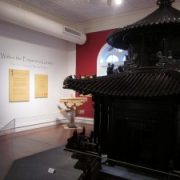Smithsonian Affiliates in the news!
This week has been busy in Affiliateland. From World Historic Site nominations to Civil War anniversary events, to welcoming new Affiliates, it’s not only the temperature that’s on fire this week!

"Crochet Coral and Anemone Garden" with sea slug by Marianne Midelburg. Photos © The IFF by Alyssa Gorelick.
Putnam Museum of History and Natural Science (Davenport, IA)Smithsonian Community Coral Reef to live on in Davenport, Iowa. READ MORE
Rubin Museum of Art (New York, NY)
It is a rare and wonderful day when The Observer can share not one but two news items from the sometimes-sleepy world of Tibetan art. READ MORE
With the support of a three-year, $270,000 grant from the Henry Luce Foundation, Dr. David Jackson–the world’s foremost scholar of Tibetan Buddhist painting and a consulting curator for the Rubin Museum–will publish a new series of exhibition catalogues on Tibetan thangka paintings drawn primarily from the museum’s collection. READ MORE
Poverty Point State Historic Site (Baton Rouge, LA)
Louisiana is working with the federal government to put the Poverty Point State Historic Site in northeast Louisiana on the World Heritage Site list. READ MORE
The prehistoric earthworks of Poverty Point in Louisiana and a collection of Frank Lloyd Wright buildings across the United States will be nominated by Interior Secretary Ken Salazar for the U.N. World Heritage List. READ MORE
Poverty Point Nominated for World Heritage List. READ MORE
HistoryMiami (Miami, FL)
One of Miami-Dade County’s oldest cultural institutions, has been accepted as a Smithsonian Affiliate. READ MORE
HistoryMiami Becomes an Affiliate of the Smithsonian Institution, Claudine Brown, Smithsonian Institution’s Assistant Secretary for Education and Access, to present HistoryMiami with Certificate of Affiliation. READ MORE
Mark the occasion as HistoryMiami becomes a Smithsonian Affiliate. READ MORE
Northwest Museum of Arts and Culture (Spokane, WA)
Forrest B. Rodgers has been appointed the new executive director of the Northwest Museum of Arts and Culture. READ MORE
Senator John Heinz History Center (Pittsburgh, PA)
History center helps antique owners put a price on the past. READ MORE
Civil War 150th Anniversary:
National Civil War Museum (Harrisburg, PA)
Without stars or bars, blue and gray flags dot the entrance to the National Civil War Museum – each representing a soldier killed in a battle the Confederates called Manassas and the North called Bull Run. READ MORE
To mark the 150th anniversary of the battle of Bull Run — the first major battle of the Civil War — The National Civil War Museum in Harrisburg set out blue and gray flags to honor all those soldiers killed in action. READ MORE
Greensboro Historical Museum (Greensboro, NC)
Combining state-of-the-art 3-D technology with American history, the Greensboro Historical Museum will offer a special program of some 170 images of President Lincoln and the Civil War era. READ MORE
Conner Prairie (Fishers, IN)
The magic of technology combines with the authenticity of characters in an outdoor historical setting to provide a truly unique experience. READ MORE
Smithsonian Affiliations Reciprocal Membership Program
Here’s a great deal you may already have access to: Paying for membership to one museum can actually mean free entry into several museums across the country. READ MORE










